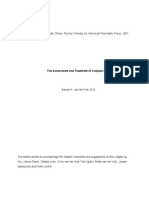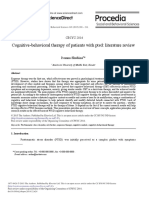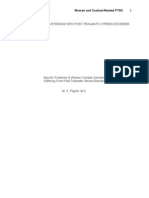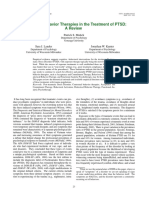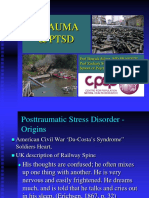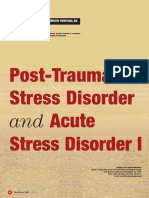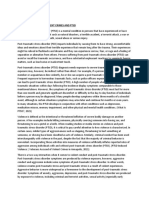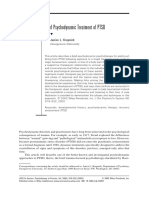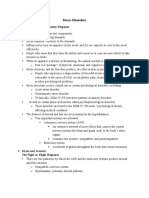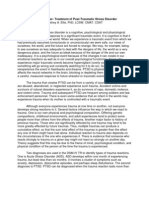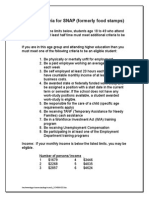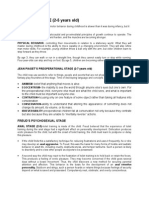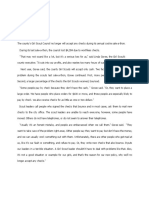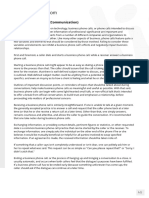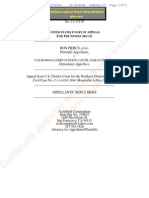How Anxiety and Fear Allow The Bogeyman
How Anxiety and Fear Allow The Bogeyman
Uploaded by
tennisnavis4Copyright:
Available Formats
How Anxiety and Fear Allow The Bogeyman
How Anxiety and Fear Allow The Bogeyman
Uploaded by
tennisnavis4Original Description:
Original Title
Copyright
Available Formats
Share this document
Did you find this document useful?
Is this content inappropriate?
Copyright:
Available Formats
How Anxiety and Fear Allow The Bogeyman
How Anxiety and Fear Allow The Bogeyman
Uploaded by
tennisnavis4Copyright:
Available Formats
How anxiety and fear allow the Bogeyman
Posttraumatic Stress Disorder:
PTSD: Phenomenon and its Empirically-Supported Treatment
Johan Rosqvist, Psy.D. Pacific University Spring 2011
Ice breaker exercise: What is PTSD?
Break into small groups / pairs What do you believe constitutes trauma?
Why is something traumatic to one person and sometimes not to another? Operationally define trauma and PTSD What kinds of etiology? Personal / professional reactions to working with it? What treatments have you employed with PTSD?
Have you worked with PTSD and/or trauma?
Come back and have larger discussion
PTSD: New and old phenomenon
DSM-III (1980): trauma-related sequelae finally classified together under common PTSD rubric Previously: separated by specific experience (e.g., combat fatigue, rape, MVA) not unified by common, similar symptoms This strong trauma response has been a known quantity for a long time (e.g., Civil War and WWIs shellshock or battle fatigue response) Question & Debate: Is it uniquely human to be predisposed for developing posttraumatic stress disorder?
Dragonfly vs. Police officer example Is a sense of future required to experience fear and trembling and the sickness unto death ? (Kierkegaard, 1954)
PTSD: Definition and terminology
Necessarily secondary to particularly distressing event(s)
Responded w/intense fear, helplessness, or horror
Unique: Etiology is known
DSM-III: Outside realm of normal human experience
What about being unconscious, then informed of what happened?????
3 major symptom clusters
Normative vs. normal Truth be told
Reliving / Reexperiencing Avoidance
Functioning distress/impairment
Arousal / Vigilance
Numbing vs. effortful avoidance
Accurately Diagnosing PTSD
Clinician driven:
Structured Clinical Interview for DSM-IV (SCID-IV) Anxiety Disorders Inventory Schedule IV (ADIS-IV) Clinician Administered Posttraumatic Scale (CAPS)
Patient driven:
Posttraumatic Stress Scale Self Rated (PSS-SR)
Cautions:
No matter which method: Consider 2 gain (malinger)
Litigation in MVA PTSD Benefits in combat PTSD
Beware psychosis Multimethod/source obviously best overall
More PTSD Instruments
Impact of Events Schedule
Intrusion/ re-experiencing Avoidance Different norms for different traumas
Horowitz, M., Wilner, N., & Alvarez, W. (1979). Impact of Event Scale: A measure of subjective stress. Psychological Medicine, 4, 209-218.
Mississippi Scale for Combat Related PTSD
Total score w/ cutoff correctly classifies 90% as PTSD.
McFall, M.E., Smith, D.E., Mackay, P.W., & Tarver, D.J. (1990). Reliability and validity of Mississippi Scale for Combat-Related Posttraumatic Stress Disorder. Psychological Assessment, 2, 114-121.
Trauma-Related Guilt Inventory
Assesses: responsibility, wrongdoing, & lack of justification norms w/ combat & battering relationships
Kubany, E.S., Haynes, S.N., Abueg, F.R., Manke, F.P., Brennan, J.J., & Stahura, C. (1996). Development and validation of the trauma-related guild inventory. Psychological Assessment, 8, 428-444.
Motor vehicle accident information
1996: Death rates for MVA = 16.2 / 100,000 2003:
Low rate behavior which statistically is not increasing with increasing populations
42,643 people died 2,889,000 people injured How many fender benders???? Exposure to heart-wrenching (toxic) life experiences is actually surprisingly common
Higher risk groups / behaviors? What does the MVA PTSD client believe will happen in future?
Larger number, but % remains stable
Normative and normal experiences
Car accidents are a normative experience: %age/year MVA induced PTSD is not a normal result of car accident
abnormal reaction to traumatic event
What differentiates between those who develop PTSD and those who dont?
Two ways of making sense of experience (assimilate/accommodate)
PTSD: Most common etiology
Overall:
1.
2.
3.
appear to be responsible for most cases of PTSD Men: Combat & witnessed violence Women: Sexual & physical assault Non-white ethnicity, personal/family hx of psychopathology, younger age (18-39) Perception of threat better predictor than
Sexual assault (65% male & 46% women; Kessler et al, 1995) Physical assault (32%; Breslau, 1998) Motor vehicle accidents (17%; Breslau, 1998)
1 wk = 94%; 1 mo = 65%; 3 mo = 65%; 17 yrs = 16.5% (Kilpatrick et al, 1987)
actual injury
PTSD Norm (epidemiological) information
60% men, 51% women have experienced traumatic event in their lives 49% of rape victims develop PTSD 4% of natural disaster survivors develop PTSD Lifetime prevalence rates 5-10%, making it amongst the most common anxiety disorder PTSD is often very debilitating, and secondary clinical problems are common
Persists for over 1 year in 50% Likely to be chronic if persists more than 3 months
High social cost: $3 Billion loss (work days lost and reduced productivity)
Overaccomodation
Overaccomodation involves an extreme distortion in schema. Accomodation vs. assimilation e.g., Instead of changing ones schema to include the possibility that some trusted individuals can be dangerous, the victim of acquaintance rape may change their schema to suggest that all men are dangerous and cannot be trusted. May result from dichotomized thought processes and restrict cognitive flexibility with which individuals should interpret and evaluate future information
Warranted conclusions
Traumatic events are common Only a minority of individuals who experience a traumatic event go on to develop PTSD One-third of those with PTSD experience a chronic course of the disorder, regardless of treatment Treatment is associated with a markedly shorter course of the disorder Individuals with PTSD often have other comorbid psychiatric diagnoses
Comorbid diagnoses
Between 60-100% of PTSDs have another Axis I (Litz, Penk, Gerardi, & Keane, 1992)
Anxiety Disorders Mood Disorders Substance Abuse or Dependence (2x as high as normal population) Marital Problems Emotional regulation, self-injurious behavior, dissociation, somatization, hopelessness, feeling damaged, loss of previous beliefs
Some Axis II may be forms of severe PTSD (e.g. BPD)
Those who develop PTSD
less social support
Before trauma (Keane et al, 1998) After trauma (Richards, 2000) Perception that post-trauma social support was less helpful (Tucker, Pfefferbaum, Nixon, & Dickson, 2000) more pre-trauma psychopathology (Keane et al, 1998)
more guilt (Bownes, O'Gorman, & Sayers, 1991; Kubany et
al, 1996)
hx of previous trauma
childhood sexual abuse w/ current sexual trauma (Nishith, Mechanic & Resick, 2000) family violence (Udwin, Boyle, Yule, Bolton, & O'Ryan, 2000)
predisposition to respond to stress w/ chronic autonomic overarousal (Jones & Barlow, 1992)
PTSD Case Illustration: Mia
28-year-old, Egyptian-American heritage, female Cohabitating with long-term boyfriend College graduate Comes from intact family, and has one younger brother No pre-morbid mental health history
Intake: I had the perfect life until all this happened.
June 30, 2003: A day of extreme trauma in Vietnam
Riding motorcycle with best friend in remote part of Vietnam Caught in landslide Fell down 60 cliff into raging river swollen from monsoon rains, almost drowned several times Broken ribs, punctured lung, mangled foot, bruised and bleeding Friend was killed, she lived Remote/primitive hospital where operation without anesthesia was performed on her foot Randomly found by American traveler and brought to Bangkok
Presentation at start of treatment: PTSD
March 27, 2004; 9 months following accident Criterion B: Reexperiencing Cluster (1 sx required)
Nightmares, Flashbacks Reactivity to exposure to cues resembling event Intrusive thoughts and memories Avoided thoughts and feelings Avoided activities, people, and places Inability to recall important aspects of accident Sleeping problems, irritability, difficulties with concentration & decisions Exaggerated startle response
Criterion C: Avoidance Cluster & Numbing (3 sxs required)
Criterion D: Arousal Cluster (2 sxs required)
What constitutes effective PTSD treatment?
Foa/Kozak: Requires exposure to corrective information
Imaginal exposure
Intense events cause fear-conditioning to a wide range of stimuli (e.g., sights, sounds, odors, and bodily responses associated with the trauma) Stimuli act as reminders of event(s), and activates fear structures (i.e., fight-flight mechanisms) Imagine trauma until emotional habituation (break link between event[s] and conditioned arousal) Exp to distressing but harmless stims (teaching stims are not dangerous)
In Vivo exposure
Cognitive Restructuring
Help person make better sense of event
Correctly appraise PTSD sxs
Im not a bad person for being in that accident, I simply was in the wrong situation at the wrong time. Repeated nightmares dont mean Im going crazy; theyre simply an indication my mind is still processing my traumatic experience.
Best predictor of optimal outcome
For patients who do not drop out of treatment, findings suggest that the most consistent
predictor of good outcome is whether or not the patient receives exposure therapy (Taylor, 2003)
Exposure is amongst the most effective treatments for PTSD (e.g., Chambless & Ollendick, 2001) Efficacy of treatment is not improved/nor diminished when exposure is diluted by adding cognitive restructuring (Foa, Dancu, et al., 1999)
Practitioner attitudes towards & utilization of exposure therapy for PTSD
Substantial evidence supports efficacy of exposure therapy for PTSD (Foa, Keane, & Friedman, 2000) Empirically-supported treatments under-utilized for anxiety disorders (Barlow, Levitt, & Bufka, 1999) Exposure under-utilized in clinical practice (Foy et al., 1996) Exposure is grossly under-utlized for PTSD (Becker, Zafert, &
Anderson, 2004)
Therapist factors affect use of exposure for PTSD
50% aware of exposure for PTSD; only 17% use it Lack of training (30% have formal training) Believe patients will drop out & symptoms will worsen Believe exposure will negatively affect relationship Believe exposure is inflexible & ignores idiosyncratic patient issues
EST for Mia: Cookbook or ????
Psycho-ed about PTSD Scheduling & Activation DB & PMR Cognitive Restructuring Exposure
In-imagination In-vivo
Grief work
1-year anniversary
Generalization training & Relapse prevention
PTSD, chronic: How bad was it????
PTCI
Scale 1: Neg cog about self - 2 std dev above clinical mean Scale 2: Neg cog about world at PTSD mean Scale 3: Self-blame (guilt) at PTSD mean
3 std dev above clinical mean (score = 52) SIAS - 2 std dev above; SPS 3 std dev above Baseline = 128 (clinical cut-off = 63)
BDI-II
SIAS/SPS
OQ-45
Treatment: How well did it work???
Mia met criteria for recovered
Started in clinical and finished in normal on all scales Passed clinical cut-offs on all scales Obtained reliable change on all scales
Start: Couldnt keep employment for more than 2 weeks End: Director of after school childrens art program
Everyday functioning
Relationships and hobbies
Adventure sports reengaged Nature passion rediscovered and extensively used
Progress and outcome: Depression, Anxiety, and Anxiety Sensitivity
BDI-II, BAI, ASI
70 60 50 40 30 20 10 0 1 2 3 4 5 6 7 8 9 10 11 12 13 14 15 16 17 18 19 Session
Severity
Progress & Outcome: BDI-II, BAI, ASI
BDI-II
Start = 3 std dev above clinical mean End = 1 std dev below normal mean Start = 1 std dev above clinical mean End = 1 std dev below normal mean Start = 1 std dev above clinical mean End = 1 std dev below normal mean
BAI
ASI
Progress and outcome: Social anxiety
SIAS and SPS
70 60 50 40 30 20 10 0 1 2 3 4 5 6 7 8 9 10 11 12 13 14 15 16 17 18 19 Session
Severity
Progress & Outcome: SIAS & SPS
SIAS
Start = 2 std dev above clinical mean End = 1 std dev below normal mean
Start = 3 std dev above clinical mean End = 1 std dev below normal mean
SPS
Progress and outcome: Posttraumatic stress
PTCI 1, 2, 3
8 7 6 5 4 3 2 1 0 1 2 3 4 5 6 7 8 9 10 11 12 13 14 15 16 17 18 19 Session
Severity
Progress & Outcome: PTCI 1, 2, and 3
PTCI 1
Start = 2 std dev above clinical mean End = at normal mean Start = at clinical mean End = 1 std dev below normal mean Start = at clinical mean End = at normal mean
PTCI 2
PTCI 3
Progress and outcome: Distress and working alliance
OQ-45, WAI
160 140 120 100 80 60 40 20 0 1 2 3 4 5 6 7 8 9 10 11 12 13 14 15 16 17 18 19 Session
Amount
Teaching cases from student perspective
Debunking myths about manual-based treatments
Flexibility and individualized (not cookie cutter) Not cruel and cold Better than a book: Live training and supervision IRL Q & A possible: Immediate feedback Teaching case did not affect working alliance or outcome Students moving from observer to therapist Increased appreciation for empiricism Increased expertise, confidence, and competence
Value of live training
Relationship
Future forward
A word or two about EMDR
Exposure yields greater proportion of patients who no longer meet criteria for PTSD after a formal treatment trial EMDR does not differ from relaxation training on any outcome measure Exposure produces significantly larger reductions in avoidance and re-experiencing sxs Exposure is faster at reducing avoidance Controversy: Emergence of EMDR had an unusual course/poor studies/better than no treatment
Probably efficacious status
A Purple Hat therapy????
You gain strength, courage and confidence by every experience in which you really stop to look fear in the face. You are able to say to yourself, I have lived through this horror. I can take the next thing that comes along. You must do the thing you think you cannot do. Do one thing every day that scares you. Eleanor Roosevelt
You might also like
- Adam's Peanut Butter Cup Fudge Ripple CheesecakeDocument2 pagesAdam's Peanut Butter Cup Fudge Ripple Cheesecaketennisnavis4100% (1)
- The Irregular at Magic High School, Vol. 16 - Yotsuba Succession ArcDocument186 pagesThe Irregular at Magic High School, Vol. 16 - Yotsuba Succession ArcPauline Occiano100% (1)
- The Problem With PurityDocument2,133 pagesThe Problem With Puritytennisnavis4No ratings yet
- A Cognitive Model of Posttraumatic Stress Disorder - Ehlers - Clark - 2000Document27 pagesA Cognitive Model of Posttraumatic Stress Disorder - Ehlers - Clark - 2000Dana Goţia100% (1)
- Eidetic Therapy For TraumaDocument93 pagesEidetic Therapy For TraumaAbbas Hasan100% (1)
- Running Head: Posttraumatic Stress Disorder 1Document10 pagesRunning Head: Posttraumatic Stress Disorder 1Ryan Rusk100% (1)
- Complex PTSDDocument29 pagesComplex PTSDLia VágvölgyiNo ratings yet
- Resumes: Dos Don'TsDocument7 pagesResumes: Dos Don'Tstennisnavis4100% (1)
- Philosophy of Education Under CommonwealthDocument2 pagesPhilosophy of Education Under CommonwealthIrish Diane Zales Barcellano100% (3)
- Essence of Learning LeadershipDocument14 pagesEssence of Learning LeadershipMiyaSquires100% (1)
- Hypnosis for Grief and Loss: A Comprehensive Guide To Coping With Loss, Grief Feeling, Pains And Finding Hope BeyondFrom EverandHypnosis for Grief and Loss: A Comprehensive Guide To Coping With Loss, Grief Feeling, Pains And Finding Hope BeyondNo ratings yet
- Research Paper: Posttraumatic Stress Disorder Abnormal Psychology Liberty University March 2, 2014Document11 pagesResearch Paper: Posttraumatic Stress Disorder Abnormal Psychology Liberty University March 2, 2014mzsjacksonNo ratings yet
- Markowitz - Interpersonal Psychotherapy For Posttraumatic Stress Disorder (2017)Document185 pagesMarkowitz - Interpersonal Psychotherapy For Posttraumatic Stress Disorder (2017)José Luis SH100% (2)
- Tept Manejo ActualDocument6 pagesTept Manejo ActualWidad LeivaNo ratings yet
- Cognitive-Behavioral Therapy of Patients With PTSD: Literature ReviewDocument9 pagesCognitive-Behavioral Therapy of Patients With PTSD: Literature ReviewDianela CastañedaNo ratings yet
- Post-Traumatic Stress Disorder - An Under-Diagnosed and Under-Treated Entity PDFDocument11 pagesPost-Traumatic Stress Disorder - An Under-Diagnosed and Under-Treated Entity PDFnegriRDNo ratings yet
- Chapter 11. Posttraumatic Stress DisorderDocument18 pagesChapter 11. Posttraumatic Stress DisorderDiego Francesco MacaliNo ratings yet
- PTSD Women Combat VeteransDocument6 pagesPTSD Women Combat VeteransMisty JaneNo ratings yet
- Mulick, P. S., Landes, S. J., & Kanter, J. W. (2011) - Contextual Behavior Therapies in The Treatment of PTSD A Review.Document10 pagesMulick, P. S., Landes, S. J., & Kanter, J. W. (2011) - Contextual Behavior Therapies in The Treatment of PTSD A Review.Magali RodriguezNo ratings yet
- Breslau Epidemiologytraumaptsd 2009Document14 pagesBreslau Epidemiologytraumaptsd 2009Patai RitaNo ratings yet
- Abstract-Trauma Therapy Evidence BasedDocument1 pageAbstract-Trauma Therapy Evidence BasedvsiedleckiNo ratings yet
- Literature Review PTSD Treatment StrategiesDocument16 pagesLiterature Review PTSD Treatment StrategiesCristina PearseNo ratings yet
- World Psychiatry - 2019 - Bryant - Post Traumatic Stress Disorder A State of The Art Review of Evidence and ChallengesDocument11 pagesWorld Psychiatry - 2019 - Bryant - Post Traumatic Stress Disorder A State of The Art Review of Evidence and ChallengesHesti Juwita P.No ratings yet
- Trauma & PTSD: Prof Derrick Silove, MD Franzcp Prof Zachary Steel, PHD, M.Clin - Psych School of Psychiatry UnswDocument33 pagesTrauma & PTSD: Prof Derrick Silove, MD Franzcp Prof Zachary Steel, PHD, M.Clin - Psych School of Psychiatry Unswleanne yangNo ratings yet
- Post-Traumatic Stress Disorder Acute Stress Disorder I: by Shawn P. Cahill, PHD, and Kristin Pontoski, BaDocument12 pagesPost-Traumatic Stress Disorder Acute Stress Disorder I: by Shawn P. Cahill, PHD, and Kristin Pontoski, BanovywardanaNo ratings yet
- Thesis For PTSD Research PaperDocument8 pagesThesis For PTSD Research Papertammykordeliskinorman100% (2)
- Symptomatology and Psychopathology of Mental Health Problems After DisasterDocument11 pagesSymptomatology and Psychopathology of Mental Health Problems After DisasterFelipe Ignacio Vilugron ConstanzoNo ratings yet
- Loc 7 PTSDDocument7 pagesLoc 7 PTSDapi-548749586No ratings yet
- Torres-Reading On PTSDDocument15 pagesTorres-Reading On PTSDbabiNo ratings yet
- Numbing After Rape, and Depth of Therapy: Mailing Address: 1 Quail Avenue, Berkeley, CADocument23 pagesNumbing After Rape, and Depth of Therapy: Mailing Address: 1 Quail Avenue, Berkeley, CAdanielaNo ratings yet
- Post Traumatic Stress Disorder (PTSD) : Integrated MedicalDocument19 pagesPost Traumatic Stress Disorder (PTSD) : Integrated MedicalGalina StupelimanNo ratings yet
- Complex Psychiatric DisordersDocument13 pagesComplex Psychiatric DisordersSammy MunyaloNo ratings yet
- Bodkin2007-Is PTSD Caused by Traumatic StressDocument7 pagesBodkin2007-Is PTSD Caused by Traumatic StressjoleguneyNo ratings yet
- 165 FullDocument18 pages165 Fullblushing.lilithNo ratings yet
- PSYCHOPATHOLOGYDocument9 pagesPSYCHOPATHOLOGYGeerthana ArasuNo ratings yet
- Post-Traumatic Stress Disorder: Theory and Treatment UpdateDocument10 pagesPost-Traumatic Stress Disorder: Theory and Treatment UpdateMarco Antonio Garcia GonzalezNo ratings yet
- The Healing Power of Active Imagination On Posttraumatic StressDocument26 pagesThe Healing Power of Active Imagination On Posttraumatic StressEvelyn Rojas SepúlvedaNo ratings yet
- Post Traumatic Stress DisorderDocument6 pagesPost Traumatic Stress DisorderBhoomika M R KrishnaNo ratings yet
- Section A: Association Between Violent Crimes and PTSDDocument8 pagesSection A: Association Between Violent Crimes and PTSDhania AfzalNo ratings yet
- The Trauma of First Episode PsychosisDocument7 pagesThe Trauma of First Episode Psychosissaurav.das2030No ratings yet
- Brief Psychodynamic Treatment of PTSD: Janice L. KrupnickDocument14 pagesBrief Psychodynamic Treatment of PTSD: Janice L. KrupnickAsri PutriNo ratings yet
- Post Traumatic Stress Trauma Informed Care and Compassion Fatigue in Psychiatric Hospital Staff A Correlational StudyDocument11 pagesPost Traumatic Stress Trauma Informed Care and Compassion Fatigue in Psychiatric Hospital Staff A Correlational StudyStephen LloydNo ratings yet
- ArticleDocument26 pagesArticlen.paunovic001No ratings yet
- PTSDpptJOMFinal - Sample 3Document56 pagesPTSDpptJOMFinal - Sample 3kabal321No ratings yet
- Trauma - and Stressor-Related DisordersDocument39 pagesTrauma - and Stressor-Related Disordersraneemghandour28No ratings yet
- 3 PTSD and Childhood TraumaDocument5 pages3 PTSD and Childhood TraumaMarvellous MunhuwaNo ratings yet
- Posttraumatic Stress Disorder (Eme Ing)Document19 pagesPosttraumatic Stress Disorder (Eme Ing)Tika Fajar WulandariNo ratings yet
- Psych 410 PTSD NotesDocument4 pagesPsych 410 PTSD Notesapi-736917344No ratings yet
- Posttraumatic Stress Disorder Epidemiology, Pathophysiology, Clinical Manifestations, and DiagnosisDocument9 pagesPosttraumatic Stress Disorder Epidemiology, Pathophysiology, Clinical Manifestations, and Diagnosisisa_horejsNo ratings yet
- PTSDDocument14 pagesPTSDAmna ZaidNo ratings yet
- Use of Cannabis in the Treatment of Post-Traumatic Stress DisorderFrom EverandUse of Cannabis in the Treatment of Post-Traumatic Stress DisorderNo ratings yet
- PTSD History and OverviewDocument8 pagesPTSD History and OverviewHellena MaNo ratings yet
- Clinical Psychology Review: Michelle L. Moulds, Madelyne A. Bisby, Jennifer Wild, Richard A. Bryant TDocument16 pagesClinical Psychology Review: Michelle L. Moulds, Madelyne A. Bisby, Jennifer Wild, Richard A. Bryant TLAURA CRISTINA TORRES CATANONo ratings yet
- PTSD - Milestone 3Document9 pagesPTSD - Milestone 3Eduardo SerrãoNo ratings yet
- Post Traumatic Stress Disorder (PTSD)Document114 pagesPost Traumatic Stress Disorder (PTSD)Gugus EkaNo ratings yet
- Clinical Manual of Emergency Psychiatry-160-205Document46 pagesClinical Manual of Emergency Psychiatry-160-205Fahrunnisa NurdinNo ratings yet
- Learn Somthing New Every Day: What Is PTSD? Pg. 2Document9 pagesLearn Somthing New Every Day: What Is PTSD? Pg. 2StevenNo ratings yet
- PTSDDocument50 pagesPTSDdrkadiyala2100% (6)
- 117 FullDocument16 pages117 FullchatikobojoelNo ratings yet
- Signature Assignment Culminating Argument (PTSD) : Capstone 401 Professor Jose Candelario July 30 2020Document24 pagesSignature Assignment Culminating Argument (PTSD) : Capstone 401 Professor Jose Candelario July 30 2020klm klmNo ratings yet
- Post Traumatic Stress DisorderDocument64 pagesPost Traumatic Stress DisorderGarima NirankariNo ratings yet
- Stress Disorders: Stress, Coping, and The Anxiety ResponseDocument18 pagesStress Disorders: Stress, Coping, and The Anxiety ResponsePsyNo ratings yet
- Trauma Concept PaperDocument7 pagesTrauma Concept Paperapi-226804663No ratings yet
- Student Criteria For SNAP (Formerly Food Stamps) : /var/www/apps/conversion/tmp/scratch - 3/240064203Document3 pagesStudent Criteria For SNAP (Formerly Food Stamps) : /var/www/apps/conversion/tmp/scratch - 3/240064203tennisnavis4No ratings yet
- 01 IE563 Intro v14Document33 pages01 IE563 Intro v14tennisnavis4No ratings yet
- Resumes: Heading / Contact Information / Profile Education Experience OtherDocument6 pagesResumes: Heading / Contact Information / Profile Education Experience Othertennisnavis4No ratings yet
- Obsessive-Compulsive Disorder: Clinical Picture and Cognitive-Behavioral Treatment ImplicationsDocument45 pagesObsessive-Compulsive Disorder: Clinical Picture and Cognitive-Behavioral Treatment Implicationstennisnavis4No ratings yet
- Panic Disorder & Its Empirical TreatmentDocument21 pagesPanic Disorder & Its Empirical Treatmenttennisnavis4No ratings yet
- The Lioness Prophecies by AMRDocument397 pagesThe Lioness Prophecies by AMRtennisnavis4No ratings yet
- Abraham Lincoln - Vampire HunterDocument232 pagesAbraham Lincoln - Vampire Huntertennisnavis4100% (1)
- UT Dallas Syllabus For Fin6320.521 06u Taught by Mark Frost (Mfrost)Document6 pagesUT Dallas Syllabus For Fin6320.521 06u Taught by Mark Frost (Mfrost)UT Dallas Provost's Technology GroupNo ratings yet
- DishaDocument12 pagesDishaSanjay SethiaNo ratings yet
- Benefits of Kaizen PresentationDocument8 pagesBenefits of Kaizen PresentationEmmanuel BilfredNo ratings yet
- Doctrine of PrivityDocument5 pagesDoctrine of PrivityRANDAN SADIQNo ratings yet
- PRESCHOOL AGE (2-5 Years Old) : Freud'S Psychosexual StageDocument5 pagesPRESCHOOL AGE (2-5 Years Old) : Freud'S Psychosexual StageZie BeaNo ratings yet
- Watson, Alan, Evolution of Law Continued, 1987Document35 pagesWatson, Alan, Evolution of Law Continued, 1987andresabelrNo ratings yet
- Leadership PhilosphyDocument5 pagesLeadership Philosphyapi-525697608No ratings yet
- 2017 August 29 MOV OBJ (Combined)Document59 pages2017 August 29 MOV OBJ (Combined)Peter T SzymonikNo ratings yet
- Q and A Tax ReviewDocument2 pagesQ and A Tax ReviewJanice0% (1)
- Research MethodologyDocument3 pagesResearch MethodologySwetank SrivastavaNo ratings yet
- Interpretation of Penal StatutesDocument37 pagesInterpretation of Penal StatutesKrishna Chaithanya Reddy PolamNo ratings yet
- Module 2 Self 3Document18 pagesModule 2 Self 3Lalaine MolinaNo ratings yet
- Alena Carisse Austria Juliana PangilinanDocument2 pagesAlena Carisse Austria Juliana PangilinanJULIANA PANGILINANNo ratings yet
- Shelley, The CenciDocument80 pagesShelley, The CenciaarzrumtNo ratings yet
- Culture Shock Chave de RespostaDocument3 pagesCulture Shock Chave de RespostaEvanilson NevesNo ratings yet
- 2.malbarosa V CADocument2 pages2.malbarosa V CAMikhel BeltranNo ratings yet
- PHILIPPINE NATIONAL OIL COMPANY, Petitioner vs. LEONILO A. MAGLASANG and OSCAR S. MAGLASANGDocument4 pagesPHILIPPINE NATIONAL OIL COMPANY, Petitioner vs. LEONILO A. MAGLASANG and OSCAR S. MAGLASANGBOT1 BOT1No ratings yet
- Dua Garis Biru - A Movie ReflectionDocument3 pagesDua Garis Biru - A Movie ReflectionKhairul AbdullahNo ratings yet
- The Essentials of Mahamudra PracticeDocument26 pagesThe Essentials of Mahamudra PracticeKarma Arnab100% (3)
- Samuel & Widiger (2011) ConscientiousnessDocument15 pagesSamuel & Widiger (2011) ConscientiousnessHemant KumarNo ratings yet
- Revised Bba Structure For BosDocument4 pagesRevised Bba Structure For Bosrupa royNo ratings yet
- Syllabus of Strategic Management of UGMDocument6 pagesSyllabus of Strategic Management of UGMArief PrasetyoNo ratings yet
- Bussiness Phone CallsDocument2 pagesBussiness Phone CallsYeison HurtadoNo ratings yet
- Constitution of MalaysiaDocument171 pagesConstitution of MalaysiaRenu SekaranNo ratings yet
- Prueba de Ingles SolucionarioDocument3 pagesPrueba de Ingles SolucionarioDavid Ruiz AlvarezNo ratings yet
- Barangay Development Plan PresentationDocument29 pagesBarangay Development Plan PresentationJesser Descartin AdanoNo ratings yet
- Appellants Reply Brief: Ronald Pierce et al vs. Chief Justice Tani Cantil-Sakauye Judicial Council Chair and Steven Jahr Judicial Council Administrative Director - Federal Class Action Lawsuit for Alleged Illegal Use of California Vexatious Litigant Law by Family Court Judges in Child Custody Disputes - Ventura County - Tulare County - Sacramento County - San Mateo County - Santa Clara County - Riverside County - San Francisco County - US District Court for the Northern District of California Judge Jeffrey S. White - US Courts for the Ninth Circuit - 9th Circuit Court of Appeal Class Action for Injunctive and Declaratory ReliefDocument46 pagesAppellants Reply Brief: Ronald Pierce et al vs. Chief Justice Tani Cantil-Sakauye Judicial Council Chair and Steven Jahr Judicial Council Administrative Director - Federal Class Action Lawsuit for Alleged Illegal Use of California Vexatious Litigant Law by Family Court Judges in Child Custody Disputes - Ventura County - Tulare County - Sacramento County - San Mateo County - Santa Clara County - Riverside County - San Francisco County - US District Court for the Northern District of California Judge Jeffrey S. White - US Courts for the Ninth Circuit - 9th Circuit Court of Appeal Class Action for Injunctive and Declaratory ReliefCalifornia Judicial Branch News Service - Investigative Reporting Source Material & Story Ideas0% (1)






